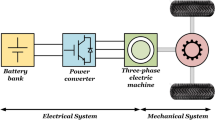Abstract
This paper proposes a constrained optimization-based torque control allocation method aimed to improve energy efficiency, and thus, driving range for electric vehicles. In the proposed method, the cost function is defined not only to achieve desired yaw moment for vehicle handling and stability, but also to minimize power losses for energy efficiency. The particular attention is paid to the power losses due to tire slips both longitudinally and laterally. The constraints are also set based on thorough investigation on various causes of power disppation such that the torque is allocated with restraint to use regenerative braking in its maximum capacity. The proposed control allocation method has been tested and verified to be effective on energy efficiency improvement through both simulation and experiment under various driving maneuvers.
Similar content being viewed by others
Abbreviations
- C a :
-
aerodynamic drag coefficient
- m :
-
vehicle mass
- V x :
-
longitudinal velocity
- R e :
-
effective tire radius
- R x :
-
force due to rolling resistance
- θ :
-
road grade angle
- β :
-
vehicle sideslip angle
- γ :
-
vehicle yaw rate
- δ :
-
front wheel steering angle
- C f, C r :
-
cornering stiffness of front and rear tires respectively
- l c :
-
half of vehicle track
- a x :
-
longitudinal acceleration
- a y :
-
lateral acceleration
- K r :
-
vehicle stability factor
- E on :
-
insulated gate bipolar transistor turn-on losses
- E on_nom :
-
insulated gate bipolar transistor turn-on losses nominal value
- E off :
-
insulated gate bipolar transistor turn-off losses
- E off_nom :
-
insulated gate bipolar transistor turn-off losses nominal value
- E rec :
-
reverse recovery losses of freewheeling diode
- E rec_nom :
-
reverse recovery losses of freewheeling diode nominal value
- f sw :
-
inverter switching frequency
- i d, i q :
-
d, q-axes current components
- i cd, i cq :
-
d, q-axes iron losses current components
- i od, i oq :
-
d, q-axes magnetizing current components
- I a :
-
armature current
- I s :
-
peak of the load current
- K :
-
weighting coefficient of error
- L d, L q :
-
d, q-axes inductance components
- p :
-
number of pole pairs
- P cs :
-
insulated gate bipolar transistor conduction loss
- P cd :
-
freewheeling diode conduction loss
- P Cu :
-
stator winding copper losses
- P Fe :
-
stator iron losses
- P loss_inverter :
-
overall losses of the inverter
- P loss_motor :
-
motor losses
- P m :
-
friction losses
- P sw :
-
switching losses of three-phase inverter
- P sw_ph :
-
switching losses of single-phase inverter
- R a :
-
stator winding resistance
- R c :
-
iron loss resistance
- R ce, R ak :
-
insulated gate bipolar transistor and freewheeling diode equivalent series resistances
- t :
-
time step
- T e :
-
electromagnetic torque
- T m :
-
friction torque
- T out :
-
motor output torque
- u d, u q :
-
d, q-axes voltage components
- V d0, V s0 :
-
insulated gate bipolar transistor and freewheeling diode zero current conduction voltage drop
- η inverter :
-
inverter efficiency
- η motor :
-
motor efficiency
- φ :
-
power factor angle
- ψ a :
-
flux linkage due to the rotor magnets
- ω s :
-
stator currents frequency
- ω m :
-
rotor mechanical speed
- m:
-
modulation index
References
Chen, Y. and Wang, J. (2012). Fast and global optimal energy-efficient control allocation with applications to over-actuated electric ground vehicles. IEEE Trans. Control Systems Technology 20, 5, 1202–1211.
Chiang, Y.-H., Sean, W.-Y. and Ke, J.-C. (2011). Online estimation of internal resistance and open-circuit voltage of lithium-ion batteries in electric vehicles. J. Power Sources 196, 8, 3921–3932.
De Novellis, L., Sorniotti, A. and Gruber, P. (2014). Design and comparison of the handling performance of different electric vehicle layouts. Proc. Institution of Mechanical Engineers, Part D: J. Automobile Engineering 228, 2, 218–232.
Dong, W., Choi, J.-Y., Li, Y., Yu, H., Lai, J., Boroyevich, D. and Lee, F. C. (2000). Efficiency considerations of load side soft-switching inverters for electric vehicle applications. Applied Power Electronics Conf. and Exposition, IEEE, 1049–1055.
Ehsani, M., Gao, Y. and Miller, J. M. (2007). Hybrid electric vehicles: Architecture and motor drives. Proc. IEEE 95, 4, 719–728.
Fernandez-Bernal, F., Garcia-Cerrada, A. and Faure, R. (2001). Determination of parameters in interior permanent-magnet synchronous motors with iron losses without torque measurement. IEEE Trans. Industry Applications 37, 5, 1265–1272.
Gao, Y., Chu, L. and Ehsani, M. (2007). Design and control principles of hybrid braking system for EV, HEV and FCV. IEEE Vehicle Power and Propulsion Conf., IEEE, 384–391.
Gao, Y. and Ehsani, M. (2006). A torque and speed coupling hybrid drivetrain-architecture, control, and simulation. IEEE Trans. Power Electronics 21, 3, 741–748.
Günther, S., Ulbrich, S. and Hofmann, W. (2014). Driving cycle-based design optimization of interior permanent magnet synchronous motor drives for electric vehicle application. Power Electronics, Electrical Drives, Automation and Motion (SPEEDAM), Int. Symp., IEEE, 25–30.
Hancock, M. J., Williams, R. A., Fina, E. and Best, M. C. (2007). Yaw motion control via active differentials. Trans. Institute of Measurement and Control 29, 2, 137–157.
Hori, Y. (2004). Future vehicle driven by electricity and Control-research on four-wheel-motored “UOT electric march II”. IEEE Trans. Industrial Electronics 51, 5, 954–962.
Hucho, W. and Sovran, G. (1993). Aerodynamics of road vehicles. Annual Review of Fluid Mechanics 25, 1, 485–537.
Inoue, K., Kotera, K., Asano, Y. and Kato, T. (2013). Optimal torque and rotating speed trajectories minimizing energy loss of induction motor under both torque and speed limits. Power Electronics and Drive Systems (PEDS), IEEE 10th Int. Conf., IEEE, 1127–1132.
Kim, J. (2016). Optimal power distribution of front and rear motors for minimizing energy consumption of 4-wheel-drive electric vehicles. Int. J. Automotive Technology 17, 2, 319–326.
Kuruppu, S. (2010). Implementation and performance evaluation of a regenerative braking system coupled to ultracapacitors for a brushless DChub motor driven electric tricycle. http://docs.lib.purdue.edu/techmasters/3
Lee, J., Nam, K., Choi, S. and Kwon, S. (2009). Lossminimizing control of PMSM with the use of polynomial approximations. IEEE Trans. Power Electronics 24, 4, 1071–1082.
Lu, D., Ouyang, M., Gu, J. and Li, J. (2014). Instantaneous optimal regenerative braking control for a permanentmagnet synchronous motor in a four-wheel-drive electric vehicle. Proc. Institution of Mechanical Engineers, Part D: J. Automobile Engineering 228, 8, 894–908.
Mokhiamar, O. and Abe, M. (2004). Simultaneous optimal distribution of lateral and longitudinal tire forces for the model following control. J. Dynamic Systems, Measurement, and Control 126, 4, 753–763.
Morimoto, S., Tong, Y., Takeda, Y. and Hirasa, T. (1994). Loss minimization control of permanent magnet synchronous motor drives. IEEE Trans. Industrial Electronics 41, 5, 511–517.
Pi, J. M., Bak, Y. S., You, Y. K., Park, D. H. and Kim, H. S. (2016). Development of route information based driving control algorithm for a range-extended electric vehicle. Int. J. Automotive Technology 17, 6, 1101–1111.
Randall, A. M. and Robertson, C. G. (2014). Linearnonlinear dichotomy of the rheological response of particle-filled polymers. J. Applied Polymer Science 131, 19.
Shen, J., Dusmez, S. and Khaligh, A. (2014). Optimization of sizing and battery cycle life in battery/ultracapacitor hybrid energy storage systems for electric vehicle applications. IEEE Trans. Industrial Informatics 10, 4, 2112–2121.
Suzuki, Y., Kano, Y. and Abe, M. (2014). A study on tyre force distribution controls for full drive-by-wire electric vehicle. Vehicle System Dynamics 52, 1, 235–250.
Urasaki, N., Senjyu, T. and Uezato, K. (2000). An accurate modeling for permanent magnet synchronous motor drives. Applied Power Electronics Conf. and Exposition, IEEE, 387–392.
Urase, K., Yabu, N., Kiyota, K., Sugimoto, H., Chiba, A., Takemoto, M., Ogasawara, S. and Hoshi, N. (2015). Energy efficiency of SRand IPM generators for hybrid electric vehicle. IEEE Trans. Industry Applications 51, 4, 2874–2883.
Wang, J. and Longoria, R. G. (2009). Coordinated and reconfigurable vehicle dynamics control. IEEE Trans. Control Systems Technology 17, 3, 723–732.
Xiao, W., Wang, F. and Zhuo, B. (2008). Regenerative braking algorithm for an ISG HEV based on regenerative torque optimization. J. Shanghai Jiaotong University (Science), 13, 193–200.
Yuan, X. and Wang, J. (2012). Torque distribution strategy for a front-and rear-wheel-driven electric vehicle. IEEE Trans. Vehicular Technology 61, 8, 3365–3374.
Zhang, Q., Deng, W. and Wu, J. (2016). A rule based energy management system of experimental battery/ supercapacitor hybrid energy storage system for electric vehicles. J. Control Science & Engineering, 2016, 1–17.
Zhang, Q. and Deng, W. (2016). An adaptive energy management system for electric vehicles based on driving cycle identification and wavelet transform. Energy 9, 5, 341.
Zhu, X., Zhang, H., Cao, D. and Fang, Z. (2015). Robust control of integrated motor-transmission powertrain system over controller area network for automotive applications. Mechanical Systems and Signal Processing, 58-59, 15–28.
Author information
Authors and Affiliations
Corresponding author
Rights and permissions
About this article
Cite this article
Zhao, Y., Deng, W., Wu, J. et al. Torque control allocation based on constrained optimization with regenerative braking for electric vehicles. Int.J Automot. Technol. 18, 685–698 (2017). https://doi.org/10.1007/s12239-017-0068-7
Received:
Revised:
Accepted:
Published:
Issue Date:
DOI: https://doi.org/10.1007/s12239-017-0068-7




